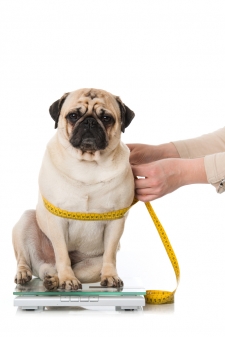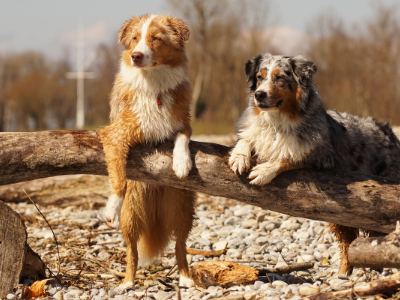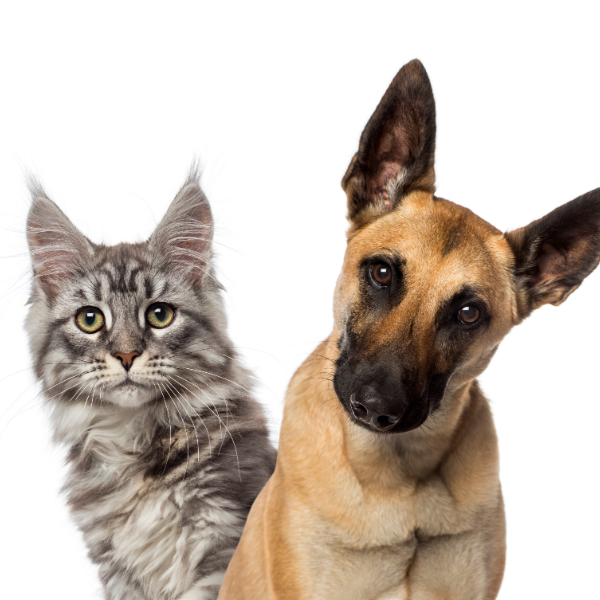The Risks of Obesity
|
|
Causes
- Improper diet
- Inadequate exercise routine
- Hypothyroidism (dogs)
- Insulinoma
- Hyperadrenocorticism
- Neutering in males
What You Can Do
Getting a handle on your pets’ obesity early on is important. Recognizing and admitting it can be hard to swallow for some but it's really important to acknowledge and fix it a soon as possible.
Diet:
Diet is probably the first thing you should look at. If your pet is currently eating high-starch dry pet food, no matter what the brand, eliminating this food source as a staple of the diet is important. Starch creates sugar which can be stored as fat and most North American pets are getting far too many starchy foods and not enough of their species-appropriate energy sources: protein and fat. Starch can be disguised in the forms of chickpea flour, pea flour, peameal, wheat/corn/soy meal, and other seemingly “healthy” commercial food additives. Do your pet a favor and eliminate the dry food. Switch to a whole food diet. Most times, this will solve the issue on its own. High protein, mid-range fat, and low carbohydrate diets are ideal for weight loss in carnivores. It will help your pet gain lean muscle mass, decrease fat storage by reducing sugar-producing foods, regulate blood sugar and increase water content which will, in turn, increase hydration and detoxifying abilities of the internal organs. 3P offers raw, whole prey-based meals which include lean muscle and lean red meats too. Our meals also don't contain a lot of high-starch foods. We also have completely starch-free options including our veggie #8 Yeast Buster formula.
Exercise:
Be honest, now. Is your pet getting enough exercise? Many lead sedentary lives. Our pets can follow in our footsteps. Make a point to get your dog out for regular walks. This will be of benefit to you as well! If your cat goes outside, he's probably active but if he's indoors, he might be lacking in this area. Playing with your cat can help increase activity and is a great way to bond too.
Hypothyroidism in dogs:
A fairly common issue among modern dogs, this disorder is diagnosed by a blood test revealing low thyroid function (hormone output). Symptoms usually precede the blood test: unexplained weight gain, lethargy, low appetite, hair loss, dull coat, excessive shedding, recurring skin infections, and intolerance to cold. A raw diet will help to give the endocrine (glandular/hormonal) system the best chance at healthy function and will cut down on excess calories that are well-utilized if the metabolism of the dog is slow. We also carry a special metabolic support veggie formula (our veggie #4).
Hyperadrenocorticism (Cushing's Disease):
Most often an issue in dogs, Cushing's is a metabolic disorder that affects pituitary and/or adrenal function. This will have an impact on your dog’s weight and must be addressed by a veterinarian. Along with correct medical treatment, a raw diet and food supplementation will greatly benefit your pet. It will help to reduce PU/PD symptoms (drinking/peeing), reduce weight, and reduce inflammation within the cells. Our Metabolic Support Blend (veggie #4) is a great nutritional support that can be included in their diet, along with rotations of lean white and red meats.
If you’re dealing with any of the above issues, you'll want to get help choosing the best raw foods for your pet by contacting us but here are a few quick tips:
- avoid lamb and duck with more fat content
- avoid processed carbohydrate altogether
- choose lots of lean muscle meats (90-95%)
- for dogs, choose a higher percentage of green veggies than starchy veggies
- give your pet a good balance of omega 3 and 6 fatty acids
- ensure that your pet is getting sufficient daily exercise
- ensure that the possibility of metabolic disorders are explored and treated by your vet
Overview
Ways that raw will help your obese pet lose weight:
- By stabilizing your pets blood sugars & insulin
- By feeding high protein, low starch meals will increase lean muscle and decrease fat
- By choosing higher-quality energy sources will satiate your pet's appetite, helping them feel full for longer
- By increasing your pet's energy and desire to play and exercise
Give your pet a healthier, longer life by feeding a healthy raw diet!



